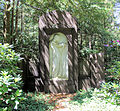Ernst Müller-Braunschweig
Ernst Müller-Braunschweig (born January 23, 1860 in Ölper near Braunschweig ; † September 7, 1928 in Berlin-Charlottenburg ) was a German businessman and sculptor .
Müller-Braunschweig, who originally worked as a merchant, had a hearing problem. After this got worse, he worked as a sculptor from 1890. As such, he was represented for the first time in 1895 in the Great Berlin Art Exhibition .
plant
Works by Müller-Braunschweig were and can be seen in Bockum-Hövel , Braunschweig , Bremen , Lübeck , Magdeburg and Worms, among others.
His main work in Braunschweig the figure of jewelry at the western end of the valid Jasperallee located Kaiser Wilhelm Bridge (now the Theater Bridge ), consisting of four female figures and four lions, 1902 revealed and during World War II removed. He also created numerous war memorials, memorials and grave monuments (including at the main cemetery in Braunschweig ) as well as portrait busts (including a sculpture by Wilhelm Raabe in the Braunschweig State Museum ).
After the mining accident in 1908 at the Radbod colliery , he created a memorial in the form of a multi-part installation dedicated to “the memory of the miners who died on November 12, 1908” .
Relief portrait of Wilhelm Raabe , Braunschweig
Water-scooping girl , school garden, Lübeck
Monument Radbodkatastrophe , Bockum-Hoevel
Monument Radbodkatastrophe , Bockum-Hoevel
Monument Radbodkatastrophe , Bockum-Hoevel
The imperial sword on the theater bridge in Braunschweig
- In the Storm (1895)
- Faith (1896)
- Decorative figures of the Kaiser Wilhelm Bridge (today Theater Bridge ) in Braunschweig (inaugurated in 1902)
- Jahndenkmal in Worms (1906)
- Memorial to those who fell in 1914/18 at the Hochheimer Höhe main cemetery in Worms (1919)
- Jägerdenkmal on the Schwerin Schelffriedhof , war memorial 1914/18 of the Grand Ducal Mecklenburg Jäger Battalion No. 14 in Schwerin (1921; destroyed after 1951)
literature
- Müller-Braunschweig, Ernst . In: Hans Vollmer (Hrsg.): General lexicon of fine artists from antiquity to the present . Founded by Ulrich Thieme and Felix Becker . tape 25 : Moehring – Olivié . EA Seemann, Leipzig 1931, p. 224 .
- Norman-Mathias Pingel: Müller-Braunschweig, Ernst. In: Manfred Garzmann, Wolf-Dieter Schuegraf (Hrsg.): Braunschweiger Stadtlexikon. Supplementary volume. 2nd edition, Meyer, Braunschweig 1997, ISBN 3-926701-30-7 , page 95 f.
Web links
- In the storm on the beach
- Radbod disaster memorial
- 100 years after the mine accident at the Radbod colliery. industrie-kultur.de, accessed on March 25, 2018 .
| personal data | |
|---|---|
| SURNAME | Müller-Braunschweig, Ernst |
| BRIEF DESCRIPTION | German merchant and sculptor |
| DATE OF BIRTH | January 23, 1860 |
| PLACE OF BIRTH | Ölper near Braunschweig |
| DATE OF DEATH | September 7, 1928 |
| Place of death | Berlin-Charlottenburg |






